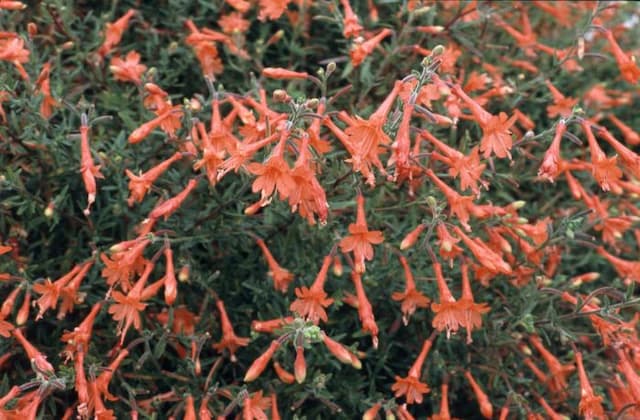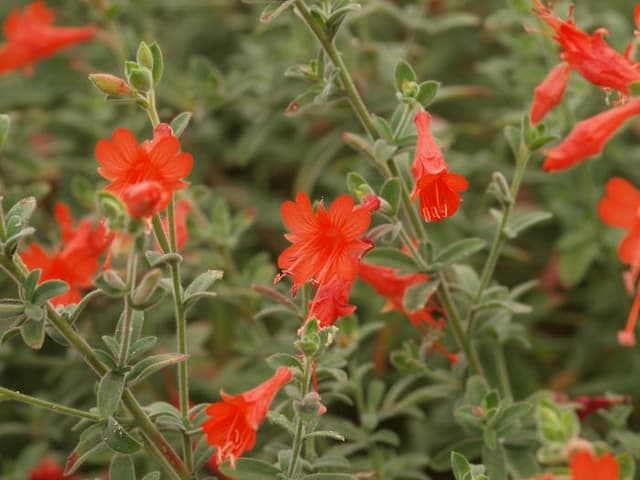White Gaura Oenothera lindheimeri 'Corrie's Gold' (G/v)

ABOUT
Corrie's Gold is a visually striking plant with a robust and upright appearance. Its foliage is particularly eye-catching with variegated leaves that combine shades of green with bold margins of creamy yellow or gold, adding a luminous contrast. During the blooming period, the plant sports an abundance of delicate flowers. These blooms are a soft, almost ethereal pink or light lavender in color, with their distinctive, slightly cupped shape being composed of four petals that flare out from a narrower base, suggesting an open and inviting look. These blooms are poised atop slender, graceful stems which arise from the foliage, creating an overall effect of softness and movement, as if the flowers are dancing atop the variegated leaves. The long bloom period results in a generous display that can be quite enchanting. This plant is characterized by its drought tolerance, making it a resilient addition to the garden and a favorite among dry climate gardeners.
About this plant
 Names
NamesFamily
Onagraceae
Synonyms
Lindheimer's Beeblossom, White Gaura, Butterfly Gaura, Wand Flower
Common names
Gaura lindheimeri 'Corrie's Gold'
 Toxicity
ToxicityTo humans
White Gaura is not generally considered toxic to humans. There's typically no concern for poisoning upon ingesting any part of the plant. However, as with any plant, individual allergies and sensitivities could potentially cause mild discomfort or reactions in some people.
To pets
White Gaura is also not known to be toxic to pets. It does not contain any known toxins that would typically cause symptoms of poisoning in animals such as cats and dogs. However, ingestion of any plant material could potentially lead to gastrointestinal upset in pets with sensitive stomachs.
 Characteristics
CharacteristicsLife cycle
Perennials
Foliage type
Semi-deciduous
Color of leaves
Variegated
Flower color
White
Height
2-3 feet (0.6-0.9 meters)
Spread
2-3 feet (0.6-0.9 meters)
Plant type
Herb
Hardiness zones
5-9
Native area
North America
Benefits
 General Benefits
General Benefits- Attracts pollinators: The Oenothera lindheimeri 'Corrie's Gold', also known as the 'Gaura', produces flowers that attract bees, butterflies, and other beneficial insects.
- Drought-tolerant: Once established, this plant is highly tolerant of drought conditions, making it suitable for water-wise gardens.
- Long blooming season: The Gaura has an extended blooming period, providing color and interest in the garden from early summer into fall.
- Low maintenance: It does not typically require a lot of care, such as frequent watering or fertilizing, making it an ideal choice for low-maintenance landscapes.
- Landscape versatility: This variety’s variegated foliage and delicate flowers provide visual interest, making it versatile for use in borders, rock gardens, and as an accent plant.
- Deer resistance: Gaura is less appealing to deer, reducing the likelihood of damage in areas where deer browse.
 Medical Properties
Medical PropertiesThis plant is not used for medical purposes.
 Air-purifying Qualities
Air-purifying QualitiesThis plant is not specifically known for air purifying qualities.
 Other Uses
Other Uses- Gaura 'Corrie's Gold' can be used as a natural dye source for textiles, offering a range of colors from its flowers and foliage.
- The fibrous stems of the plant can be woven into small crafts and baskets, as a representation of sustainable art materials.
- The plant's nectar-rich flowers can serve as a food source for making gourmet honey when cultivated near beehives, influencing the taste and quality of the honey.
- Gaura 'Corrie's Gold' can be planted as part of a butterfly garden to attract and support pollinators, contributing to biodiversity.
- The dried stalks of the plant can be utilized as natural stakes for supporting other plants in the garden.
- When dried, the delicate flowers and textured leaves are used for creating aesthetic, natural potpourri blends.
- Gaura 'Corrie's Gold' can be used in floral arrangements as a filler, particularly in wildflower or rustic bouquets for events.
- Its seeds can be collected and used for educational purposes, to teach about plant biology and lifecycle in schools and workshops.
- As an ornamental plant, it can be used in landscape design to create patterns and color contrasts in public parks or gardens.
- The plant serves as a natural erosion control agent on slopes or banks, due to its extensive root system.
Interesting Facts
 Feng Shui
Feng ShuiThe White Gaura is not used in Feng Shui practice.
 Zodiac Sign Compitability
Zodiac Sign CompitabilityThe White Gaura is not used in astrology practice.
 Plant Symbolism
Plant Symbolism- Resilience: Oenothera lindheimeri, commonly known as Gaura, often symbolizes resilience as it is a hardy plant that can withstand tough conditions and still thrive.
- Innocence: The delicate white flowers of the Gaura plant can represent purity and innocence, reminiscent of its gentle and unassuming presence in gardens.
- Freedom: The way Gaura's flowers dance and flutter in the breeze can be symbolic of freedom and the joy of life, reflecting an unchained and natural spirit.
- Peace: Gaura's soft visual appeal and its tendency to blend with other plants impart symbols of peace and harmony in a natural setting.
 Water
WaterGaura, commonly known as Whirling Butterflies, should be watered deeply but infrequently to encourage a strong root system. Allow the top inch of soil to dry out before watering again. During the growing season, watering once a week with about one gallon of water per plant should suffice, adjusting for rainfall. In hotter, dryer periods, more frequent watering may be necessary. Over the winter, reduce watering significantly as the plant is dormant and requires less moisture.
 Light
LightWhirling Butterflies thrive in full sun, where it can receive at least 6 to 8 hours of direct sunlight daily. The ideal spot for this plant would be an unobstructed southern or western exposure to ensure plenty of bright light.
 Temperature
TemperatureWhirling Butterflies can tolerate a wide range of temperatures but prefer a range of 60°F to 90°F. The plant is hardy at minimum temperatures of 10°F, though it may go dormant in colder climates. The ideal temperature for vigorous growth and blooming is between 70°F and 85°F.
 Pruning
PruningWhirling Butterflies should be pruned to remove spent flowers and encourage further blooming, revitalize plant growth, and maintain a tidy appearance. Pruning should be done in late winter or early spring before new growth begins. Cut back the plant by about one-third to stimulate fresh growth. Deadheading, or removing old blooms, can be done throughout the flowering season to enhance the plant's appearance and encourage more flowers.
 Cleaning
CleaningAs needed
 Soil
SoilGaura, commonly known as Whirling Butterflies, thrives in a soil mix that is well-draining and fertile. A blend of loamy garden soil, peat, sand, or perlite to ensure proper drainage, and a small amount of compost for fertility works well. The pH should be slightly acidic to neutral, ranging from 5.5 to 7.0.
 Repotting
RepottingGenerally, Gaura doesn't require frequent repotting and can thrive in the same spot for several years. You should consider repotting every 2 to 3 years to refresh the soil and to manage size if the plant becomes too large for its current container.
 Humidity & Misting
Humidity & MistingGaura, referred to as Whirling Butterflies, is tolerant of a wide range of humidity levels. Ideally, this plant prefers average room humidity levels, but it is quite adaptable and does not have specific humidity requirements. It's more important to provide good air circulation.
 Suitable locations
Suitable locationsIndoor
Place in bright, indirect light and well-draining soil.
Outdoor
Full sun, well-draining soil, and regular watering.
 Life cycle
Life cycleOenothera lindheimeri 'Corrie's Gold', commonly known as Gaura or Whirling Butterflies, initiates its life cycle as a seed, which, when sown in favorable conditions, germinates and develops into a seedling. The plant then enters the vegetative stage where it establishes a rosette of foliage and begins to grow rapidly, forming a strong root system. As it matures, Gaura produces tall, slender stems with lance-shaped leaves, and enters the flowering stage, showcasing delicate flowers typically white or pink with a hint of gold, which flutter in the breeze resembling butterflies. After pollination, flowers develop into fruit containing seeds, completing the reproductive phase. The Gaura is a perennial, thus it enters a dormancy period during the cold months where growth slows down or ceases, only to resume with the arrival of warmer weather. Over several years, the Gaura may spread and require division to maintain vigor or to propagate new plants.
 Propogation
PropogationPropogation time
Spring-Summer
The most popular method of propagation for Oenothera lindheimeri 'Corrie's Gold', commonly known as Gaura or Whirling Butterflies, is by taking stem cuttings. This is typically done in late spring or early summer when the plant is actively growing. The gardener should select a healthy, non-flowering stem and cut a 4 to 6-inch (10 to 15 cm) portion just below a leaf node. The lower leaves are then removed, and the cutting can be dipped in rooting hormone powder to encourage root development. The prepared cutting is then placed in a well-draining potting mix, ensuring that at least one node is buried where roots can form. The cutting should be kept moist and in indirect sunlight until roots have established, which usually takes a few weeks, after which it can be transplanted to a permanent location.









